
Ponte is the 5th rione of Rome, identified by the initials R. V, and is located in Municipio I. Its name comes from Ponte Sant'Angelo, which connects Ponte with the rione of Borgo. This bridge was built by Emperor Hadrian in 134 AD to connect his mausoleum to the rest of the city. Though Pope Sixtus V changed the rione limits, so that the bridge belongs now to Borgo, not to Ponte anymore, the area has kept its name and a bridge as its coat of arms.

The Via Giulia is a street of historical and architectural importance in Rome, Italy, which runs along the left (east) bank of the Tiber from Piazza San Vincenzo Pallotti, near Ponte Sisto, to Piazza dell'Oro. It is about 1 kilometre long and connects the Regola and Ponte Rioni.
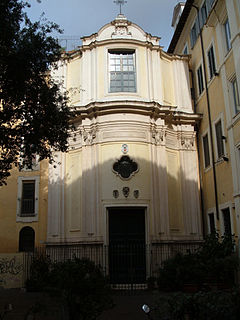
Santa Maria della Quercia is a Roman Catholic church located on the piazza of the same name, one block southeast of the Palazzo Farnese in the Rione (district) of Regola of central Rome, Italy.

San Giovanni Calibita is a Roman Catholic church located in the rione of Ripa on the Isola Tiberina, next to the Fatebenefratelli Hospital.

The Chiesa di Santa Rita da Cascia in Campitelli is a deconsecrated church in Rome (Italy), in the rione Sant'Angelo; it is located in Via Montanara, at the crossroad with Via del Teatro Marcello. The church formerly rose on the preexisting church of San Biagio de Mercato, dating at least to the 11th-century. The remains of St Blaise putatively were discovered during the dismantling of Santa Rita.

Santo Spirito dei Napoletani is a Roman Catholic church on via Giulia, in the Regola rione of Rome. It was the national church of the Kingdom of the Two Sicilies and is now the regional church for Campania.

San Giovanni Battista dei Genovesi is a Roman Catholic church on via Anicia in the Trastevere district of Rome. It is the regional church for Genoa.
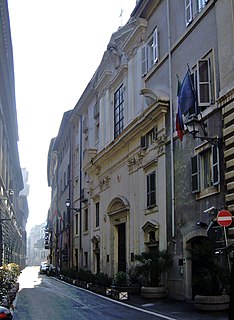
Santissimo Sudario all'Argentina or Santissimo Sudario dei Piemontesi is a church in Rome, sited on the via del Sudario in the Sant'Eustachio district. It is the subsidiary church of the military orders in Italy. It was also once the national church of the Kingdom of Sardinia and is now the regional church for Piedmont and Sardinia. It houses a replica of the Turin Shroud.

Santa Caterina da Siena is a church in Rome dedicated to Catherine of Siena. It is sited on via Giulia in the Regola district.
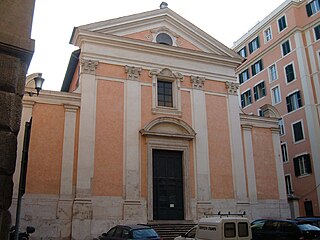
Santa Croce e San Bonaventura alla Pilotta or Santa Croce e di San Bonaventura dei Lucchesi is a church in Rome, sited on via dei Lucchesi in the Trevi district, between the Trevi Fountain and the Pontificia Università Gregoriana. It is Lucca's regional church in Rome.
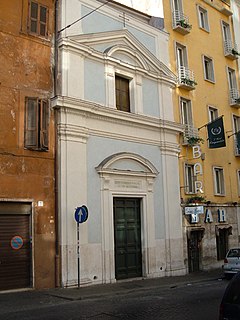
San Basilio agli Orti Sallustiani is a rectory church in Rome, on via Trevi in the Trevi district. It is dedicated to Saint Basil. The church is a secondary place of worship for the Parish of San Camillo de Lellis.

Santo Stanislao dei Polacchi, also known as San Stanislao alle Botteghe Oscure, is a Roman Catholic church in Rome, sited on Via delle Botteghe Oscure in the Sant'Angelo rione. It is the national church of Poland in Rome.
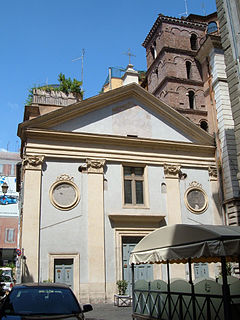
San Salvatore alle Coppelle is a church in Rome, on piazza delle Coppelle in the Sant'Eustachio district.

Sant'Antonio abate all’Esquilino is a church in Rome, located near the Basilica of Santa Maria Maggiore on via Carlo Alberto in the Esquilino district.
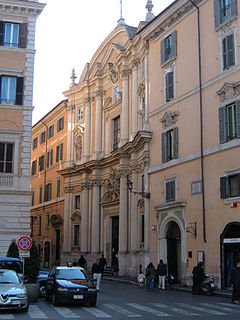
Santissima Trinità a Via Condotti or Santissima Trinità degli Spagnoli is a church in Rome at the start of via Condotti in the Campo Marzio district. It is one of the national churches of Spain in Rome.

Natività di Gesù is a church on Piazza Pasquino in the Parione rione of Rome. It is the national church in Rome of the Democratic Republic of Congo.
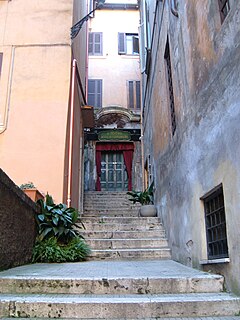
Santi Simone e Giuda is a deconsecrated Catholic church in the center of Rome, Italy. It is important for historical reasons.

Sant'Agata in Trastevere is one of the churches of Rome, located in the Trastevere district, at Largo San Giovanni de Matha, 91.

Santa Maria in Montesanto is a church of Rome, in the Rione Campo Marzio, which stands in Piazza del Popolo, between Via del Corso and Via del Babuino. It is also known as the Church of the Artists. The church is popularly known as the twin church of Santa Maria dei Miracoli, though it shows significant differences especially in the planimetry.

San Filippo Neri is a deconsecrated church in Rome, important for historical and artistic reasons. The church, facing the Via Giulia, was built during the Baroque age. San Filippo was supposed to be demolished together with the surrounding neighborhood in the late 1930s, but due to the onset of WWII the demolition was halted. Abandoned and desecrated after the war, it has been restored in 2000, but maintains a secular usage and is not accessible.





















